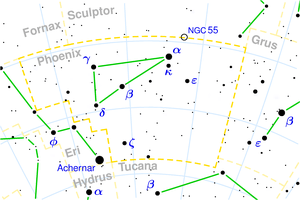|
|
Phoenix is a minor southern constellation, introduced by Dutch navigators Pieter Dirkszoon Keyser and Frederick de Houtman, and popularized by Johann Bayer's Uranometria in 1603. There are only two stars in the whole constellation which are brighter than magnitude 5.0. The constellation stretches from roughly −39° to −57° declination, and from 23.5h to 2.5h of right ascension. This means it is generally invisible to anyone living north of the 40th parallel in the Northern Hemisphere, and remains low in the sky for anyone living north of the equator. It is easily visible from locations such as Australia and South Africa during Southern Hemisphere summer. Phoenix is associated with the minor Phoenicids meteor shower of December 5th. History The introduction of a Phoenix into modern astronomy was, in a measure, by adoption rather than by invention. But, whether Bayer knew it or not, his title is an appropriate one, for with various early nations - at all events, in China, Egypt, India, and Persia - this bird has been "an astronomical symbol of cyclic period" some versions of the well-known fable making its life coincident with the Great Year of the ancients beginning at noon of the day when the sun entered among the stars of Aries; and, in Egypt, with the Sothic Period when the sun and Sirius rose together on the 20th of July. Thompson further writes of this: "A new Phoenix-period is said to have commenced AD 139, in the reign of Antoninus Pius; and a recrudescence of astronomical symbolism associated therewith is manifested on the coins of that Emperor". Coincidentally, Ptolemy adopted as the epoch of his catalogue the year AD 138, the first of Antoninus. [SLM p.335]. With the Egyptians, who knew this bird as Bennu and showed it on their coins, it was an emblem of immortality; indeed it generally has been such in pagan as well as in Christian times. In China the constellation was Ho Neaou, the firebird. [SLM p.335]. Alpha Phoenici has the name Ankaa from an Arabic word meaning the boat. References * Ian Ridpath and Wil Tirion (2007). Stars and Planets Guide Links
Retrieved from "http://en.wikipedia.org/"
|
|
|||||||||||||||||||||||||||||||||||||||||||

